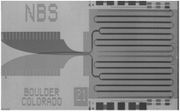Volt
2008/9 Schools Wikipedia Selection. Related subjects: Electricity and Electronics
The volt (symbol: V) is the SI derived unit of electric potential difference or electromotive force . It is named in honour of the Italian physicist Alessandro Volta (1745–1827), who invented the voltaic pile, the first modern chemical battery.
Definition
The volt is defined as the potential difference across a conductor when a current of one ampere dissipates one watt of power. Hence, it is the base SI representation m2 · kg · s-3 · A-1, which can be equally represented as one joule of energy per coulomb of charge, J/C.
Josephson junction definition
Since 1990 the volt is maintained internationally for practical measurement using the Josephson effect, where a conventional value is used for the Josephson constant, fixed by the 18th General Conference on Weights and Measures as
- K{J-90} = 0.4835979 GHz/µV.
Hydraulic analogy
In the hydraulic analogy sometimes used to explain electric circuits by comparing them to water-filled pipes, voltage is likened to water pressure - it determines how fast the electrons will travel through the circuit. Current (in amperes), in the same analogy, is a measure of the volume of water that flows past a given point, the rate of which is determined by the voltage, and the total output measured in watts. The equation that brings all three components together is: volts × amperes = watts
Common voltages
Nominal voltages of familiar sources:
- Nerve cell action potential: around 30 mV
- Single-cell, rechargeable NiMH or NiCd battery: 1.2 V
- Mercury battery 1.355 V
- Single-cell, non-rechargeable alkaline battery (e.g. AAA, AA, C and D cells): 1.5 V
- Lithium polymer rechargeable battery: 3.75 V
- Transistor-transistor logic (TTL) power supply: 5 V
- PP3 battery: 9 V
- Automobile electrical system: "12 V", about 11.8 V discharged, 12.8 V charged, and 13.8-14.4 V while charging (vehicle running).
- Household mains electricity: 240 V RMS in Australia, 230 V RMS in Europe, Asia and Africa, 120 V RMS in North America, 100 V RMS in Japan (see List of countries with mains power plugs, voltages and frequencies)
- Rapid transit third rail: 600 to 700 V (see List of current systems for electric rail traction)
- High speed train overhead power lines: 25 kV RMS at 50 Hz, but see List of current systems for electric rail traction for exceptions.
- High voltage electric power transmission lines: 110 kV RMS and up (1150 kV RMS is the record as of 2005)
- Lightning: Varies greatly, often around 100 MV.
Note: Where 'RMS' ( root mean square) is stated above, the peak voltage is  times greater than the RMS voltage for a sinusoidal signal.
times greater than the RMS voltage for a sinusoidal signal.
History of the volt
In 1800, as the result of a professional disagreement over the galvanic response advocated by Luigi Galvani, Alessandro Volta developed the so-called Voltaic pile, a forerunner of the battery, which produced a steady electric current. Volta had determined that the most effective pair of dissimilar metals to produce electricity was zinc and silver. In the 1880s, the International Electrical Congress, now the International Electrotechnical Commission (IEC), approved the volt for electromotive force. The volt was defined as the potential difference across a conductor when a current of one ampere dissipates one watt of power.
Prior to the development of the Josephson junction voltage standard, the volt was maintained in national laboratories using specially constructed batteries called standard cells. The United States used a design called the Weston cell from 1905 to 1972.
| This SI unit is named after Alessandro Volta. As with every SI unit whose name is derived from the proper name of a person, the first letter of its symbol is uppercase (V). When an SI unit is spelled out in English, it should always begin with a lowercase letter (volt), except where any word would be capitalized, such as at the beginning of a sentence or in capitalized material such as a title. Note that "degree Celsius" conforms to this rule because the "d" is lowercase. — Based on The International System of Units, section 5.2.
|



